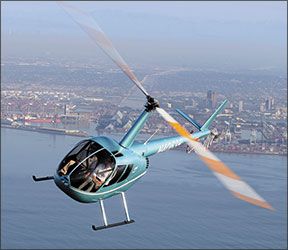Pilots looking for a used aircraft usually have a mission in mind: Carry a specific payload over a certain distance in a minimum amount of time. And if you need to get to and from remote locations while mixing it up at nearby Big City International, you might have overlooked the helicopter.
Until the early 1990s, anyone needing a personal helicopter configured for more than two or three seats had to go the turbine route; there were no piston-powered four-passenger helicopters. That changed in late 1992 when the Robinson Helicopter Company obtained FAA certification of its R44, a four-place rotorcraft powered by a Lycoming piston engine.
While offerings from Enstrom, Schweizer, Brantley and even the venerable Bell 47 have proven popular, none of them seat more than a pilot and two passengers at most. Robinson’s R44, on the other hand, takes the standard two-plus-two seating configuration of the a personal airplane and gives it a vertical takeoff and landing capability. The result is a hugely popular four-seat single—that just happens to have a rotary wing. Robinson sold 664 copies of the R44 in 2007, which was around the end of the heyday of a booming market.
History
Frank Robinson’s dream of a small, low-cost helicopter convinced him to resign from the Hughes Helicopter Company in 1973 and found the Robinson Helicopter Company (RHC). The two-place R22 quickly became the world’s top-selling civil helicopter and turned Robinson into what many think of as the “Henry Ford of helicopters.”
But the R22 hasn’t been without its rough spots. Although RHC didn’t intend it to be one of the world’s most popular trainers, that’s what it soon became. The R22 was tarnished by a number of accidents, and the lightweight rotor system resulted in little inertia, increasing the likelihood of low rotor RPM, blade stalls and fuselage strikes. Also, the rotor design itself, being of the semi-rigid type, where the rotors are free to tilt with respect to the main rotor shaft, allows the blades to see-saw or flap together. Its larger brother, the R44 Raven, didn’t come along until 1992, but it inherited some of the R22’s DNA, including a heavier but still relatively lightweight semi-rigid main rotor. In the mid-1980s, RHC began developing the four-seat R44 Raven. Its FAA certification was obtained in late 1992, and deliveries began in 1993. By early 2001, more than 1000 R44 helicopters had been delivered in 50 countries, with the R44 quickly becoming more popular than the R22. Robinson billed the type as delivering “the performance of an expensive turbine helicopter at an affordable piston price.” Then it offered a turbine version, the R66.
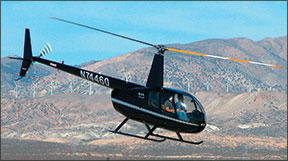
That machine retains many of the design features of the R44, including a two-blade rotor system, T-bar cyclic and an open interior cabin configuration. It’s powered by Rolls-Royce RR300 300 SHP turboshaft derated to 270 SHP for takeoff and 224 SHP continuous.
Performance
The current R44 Raven comes in two flavors. The Raven I is powered by a carbureted Lycoming O-540-F1B5 engine rated at 225 HP for a five-minute takeoff and 205 HP all other times. The fuel-injected Raven II flies with an IO-540-AE1A5 of 245 HP for five minutes and 205 HP continuous.

In addition to upscaling the R22 and tacking on two additional seats, the R44 has a hydraulic flight control system. All R44s share that system, as we’ll as fuselage and rotor components. Both Ravens also are available in RHC’s Clipper configuration, which includes fixed floats for over-water operation. When the fixed floats are installed, an 80-knot indicated airspeed never-exceed limitation is imposed.
The R44 Ravens also are available in IFR Trainer trim, which adds an artificial horizon and turn coordinator, along with a marker beacon receiver, to the standard equipment list. Meanwhile, the Raven II can be purchased in three-seat Police Helicopter and Newscopter configurations.
A new R44 Raven I carries a base list price of $320,000; a new Raven II’s pricing starts at $387,000. Paying close to around $5.50 a gallon for 100LL and budgeting realistic amounts for maintenance and the 2200-hour overhaul, direct operating costs of an R44 are in the $170 per hour range.
Max gross weight for the Raven I is 2400 pounds; for the Raven II, it’s 2500 pounds. The current-production Raven II is billed as weighing 1506 pounds empty, leaving a 994-pound useful load. Standard fuel capacity is 30.6 usable gallons, while auxiliary fuel totals another 18.3 usable.
Cruise speed is billed as no more than 117 knots and its no-reserve maximum range is about 400 miles, according to RHC. Maximum operating density altitude is 14,000 feet, but the FAA TC limits the R44 to no higher than 9000 feet AGL, to allow landing within five minutes in case of fire.
Safety
It helped keep manufacturing costs and gross weight low, but that low-inertia rotor system was an early source of problems for the Robinson fleet. Helicopters with semi-rigid rotors are vulnerable to a condition known as mast bumping, which can cause the rotor flap stops to shear the mast, resulting in loss of the main rotor. Mast bumping is normally encountered during low-G maneuvers and is not peculiar to the R22 or R44.
In fact, helicopter engineers maintain any two-blade helicopter is susceptible to mast bumping, including the ubiquitous Bell UH-1 of Vietnam and its civilian siblings. One of the keys to coping with the combination is avoiding any low-G conditions.
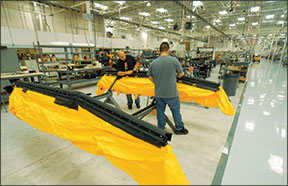
But that solution either wasn’t readily apparent to instructors and students or didn’t sink in. By 1994, the R22 was the subject of three special certification reviews conducted by the FAA. The R44, the NTSB noted in that year, might have been subject to a “lack of oversight” in the design certification process, which may have contributed to one or more accidents of the still relatively new airframe. As one result of the NTSB recommendation, the R44 was added to the third and final FAA special certification review. In September 1994, the NTSB stated it considered the FAA’s reaction to its recommendations acceptable.
In 1995, Special Federal Aviation Regulation (SFAR) 73 was issued against the R22 and R44, requiring minimum experience and training in excess of Part 61 requirements before performing pilot-in-command and/or flight instructor duties. Among other requirements, the SFAR mandates “awareness training” in energy management, mast bumping, low rotor RPM, low-G hazards and rotor RPM decay. An annual flight review in an R22/R44 is required before serving as PIC. Additionally and for transitioning fixed-wing pilots, the SFAR requires a person not holding a rotorcraft category and helicopter class rating to have at least 20 hours of dual instruction in a R44 before soloing it.
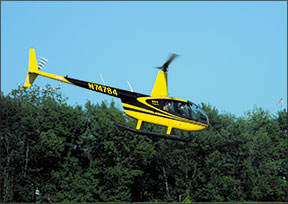
By most accounts, the SFAR did what it was designed to do—increase pilot awareness of the R22/R44’s design differences when compared to other helicopters—and the accident rate began dropping. Today, SFAR 73 has served as a model for other safety measures, including a recent review of the Mitsubishi MU-2 series. The FAA extended the “temporary” SFAR 73’s termination date to June 30, 2009.
One other item involving the R44’s safety deserves mention: the T-bar cyclic control. Most helicopters have two cyclic sticks poking up from the floor in front of the pilot seats. The Robinsons have a cyclic coming up from the center of the ship with horizontal arms at the top. If the left side arm is attached (Robinsons are flown from the right seat), either pilot can apply pressure to the cyclic. A downside is that even with the left controls removed, the cyclic is close to a passenger’s right leg and arm, making him or her much more likely to nudge it accidentally.
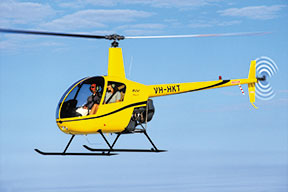
Training/Insurance
Fixed-wing pilots have been known to describe learning to hover a helicopter as the aeronautical equivalent of trying to stand on two well-greased bowling balls stacked atop each other. Regardless, you’ll need to obtain at least the minimum training required by SFAR 73 before serving as PIC in your R44. Even though adding on rotorcraft category and helicopter class privileges to your fixed-wing certificates isn’t free, it should be less expensive than starting from scratch.
One training facility with which we’re familiar suggests budgeting around $19,000 to add on private R44 privileges to an existing fixed-wing certificate. That presumes all rotorcraft time will be in the R44; some cost savings can be found by using the less-expensive R22.
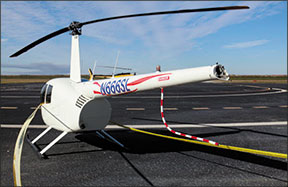
Competition
As we noted at the top, the R44 really has no competition from other four-seat piston-powered helicopters. Still, offerings from Bell, Enstrom, Schweizer and Brantley do compete in the used market. Only the Enstrom and Schweizer remain in production, however, and—except for Bell’s 47—there simply weren’t that many of them produced.
Reinforcing the concept that the R44 is really in a class by itself is the fact none of the other piston-powered helicopters can seat four; they only accommodate three and do it by placing everyone on the same bench-style seat. Except for the R44, one must keep climbing the market ladder until reaching the Bell 206 and the Hughes 500—both of which are turbine-powered. As mentioned, there’s also the R66—the turbine-powered Robinson.
Maintenance/Costs
Operators report that R44s require minimal service between 100-hour inspections and parts are reasonably priced; one likened the pricing to automobile parts. Unlike many other aircraft manufacturers, RHC makes its parts price list available on its website. RHC strongly recommends overhauling the engine and major items like gearboxes, rotor blades, bearings and the like at 2200 hours, or 12 years. In fact, the milestone is mandatory for commercial operators. While voluntary for privately operated R44s, it’s a good idea since, as one operator notes, most of the important parts are largely used up and due for replacement by then, anyway.
Three choices exist to perform the overhaul: Fly the R44 to Robinson’s factory where company workers will make it like new on the production assembly line, including its cosmetics; buy an overhaul kit and have a third party perform the labor; or have your local mechanic do the work using the same overhaul kit.
The list of components in the factory overhaul kits is long; letting the factory do the work means even items not in the kit will be replaced if needed and the ship’s paint, interior, placards and the like will be brought back to as-new condition.
Robinson breaks costs into three main areas, including a Lycoming factory remanufactured engine at $35,000, the overhaul parts kit at $126,000 and labor (240 man-hours at $90) for $21,600. Grand total, according to Robinson’s 2014 estimate of operating costs: $182,600, which works out to $83.00 per hour for a maintenance reserve, higher if you get to 12 years without reaching 2200 hours. That’s for the basic helicopter, without unscheduled maintenance issues, nor any consideration for avionics.
Figure in fuel at $6.10 and 15 GPH ($91.50), oil and periodic inspections at $16 an hour and you have the basics for determining direct operating costs. Add it all together and it comes to $213.67 hourly operating costs.
One question you might ask would be, how does RHC get 2200 hours out of a Lycoming O-540 before overhauling it, when most other applications of this engine reach TBO at either 1800 or 2000 hours? The answer is in the footnotes accompanying Lycoming’s service instruction setting TBO, which allows an extra 200 hours for the two engine types used in the R44 I and II when “an engine is being used in frequent type service and accumulates 40 hours or more per month, and has been so operated consistently since being placed in service.”
A result of complying with the 2200 hours/12-year overhaul requirement is flying what is basically a brand-new helicopter every time that milestone rolls around. Another is that resale value is maintained—most prospective buyers will want to use the R44 at least some of the time for commercial purposes and will have to comply with the overhaul requirements, anyway. Too, complying with—and documenting—the overhaul and other factory maintenance recommendations eliminates problems when selling your R44. The downside is your wallet is a lot lighter.
Mods/Type Club
The mods available for the R44 make it better suited for the kind of special mission at which helicopters excel. Examples include external storage pods from New Zealand manufacturer Helipod, a cargo hook system available from various vendors, aftermarket emergency float kits and “bear paws”—flat-plate metal attachments designed to prevent the skids from sinking into soft ground. Also offered by various vendors and STC holders are mods like engine monitors and Precise Flight’s Pulselite system. Available for the carbureted R44 Raven I is an STC allowing automotive gasoline.
We’re not aware of a formal type club for the Robinson fleet, but the Robinson Helicopter Owners Group (RHOG) comes close, at www.robinsonhelicopters.org.
Owner Comments
Robinson’s R44 is probably the best helicopter in the world for personal ownership; it also might be the best helicopter for primary training. I’m heavily involved in R44 ownerships, which are used for transition training/time building and for personal transportation.
When comparing the two models, the Raven II offers another 50 pounds of payload, but most owners use that up with options such as air conditioning and pop-out floats. Baggage is stored underneath the seats. The crushability of the seats is a primary protection in a crash. People have broken their backs in accidents that they might have walked away from if they had simply avoided putting non-crushable items under the seats. If you’re going to carry the wheels, for example, keep one under each seat and make sure that the steel handle is flat.
I find the R44 more comfortable than my Cirrus SR20 airplane and more comfortable than the seats in a lot of light airplanes. Heat is ample and uniformly distributed throughout the cabin. The fresh air supply is good, but noisy. We try to use the little vent windows cut into the doors and, if that isn’t enough, removing a door. The noise of the fresh air system is audible over the noise of an open door.
If you put in a control input, the helicopter responds immediately and dramatically. A heavier helicopter responds more gradually. The R44 is like a sports sedan; the big turbine helicopters are like trucks. The piston engine provides instant power changes without the spool-up time of a turbine.
Aside from oil changes, nothing in the R44 requires service between 100-hour inspections. Direct operating costs are approximately $170 per hour.
At 500 hours, our Raven I began to make some ugly noises when we attempted to start it. At the 100-hour inspection, the mechanics found broken teeth on the ring gear (engine side) and on the B&C brand starter. The most likely explanation is that someone tried to start the engine and it failed to catch, and then they tried again without waiting long enough for the starter motor to stop spinning. My Raven I has been virtually trouble-and-maintenance free.
Our chief mechanic reports that every part ordered from Robinson has been shipped the same day that it was ordered, a significant contributor to the high availability that we have had during 750 hours of operation. Parts are reasonably priced, similar to what you’d expect to pay for car parts.
Unlike other brands of helicopters, the R44 has one big time-in-service limit: 2200 hours or 12 years. When you reach that point, the ship must be overhauled. You can send it back to the factory or you can buy an overhaul kit and have your mechanic do the work. The latter is less expensive, but the ship won’t as nice cosmetically.
Problems with two factory-new R44 Raven I IFR trainers that we purchased involved downtime. One encountered a bird, resulting in a bird fatality and a damaged rotor blade. The flight school sat on the useless helicopter for three months before Robinson was able to deliver a replacement main rotor blade.
Once during the ferry flight of a 2008 R44 Raven I IFR Trainer, the steam gauge attitude indicator failed. Robinson wanted us to pull the old attitude indicator from the ship, placard everything inop, fax them the next day to remind them to look at the old one and call them the day after that as an additional reminder. Our flight school’s head of maintenance noted, “Any other aircraft company would have overnighted us a new one and taken the old one back.” As a result, we lost weeks of revenue because we couldn’t teach any instrument students.
The R44’s long range and practicality for cross-country trips make the T-bar cyclic perhaps more dangerous than in the R22. On a long trip, people get bored. They start talking. When the non-flying person is talking, he or she is likely to be gesturing, possibly whacking the T-bar or the cyclic tube itself.
If the flying pilot doesn’t have a firm grip on the controls, there is a possibility of the cyclic being pushed full forward, which might lead to a low-G situation, an improper full left cyclic input and mast bumping. I have encountered high-time Robinson pilots who’ve been scared by accidental knocks to the T-bar and who wish the R44 had conventional cyclics.
I fly the R44 while wearing foam earplugs and a noise-cancelling headset. The speakers in a Bose headset cannot handle the full power of an aviation radio. So if you crank up the volume on your radio to hear it through the earplugs, you’ll blow out the speakers in the Bose headsets. Bose headsets, though comfortable, are not very rugged and I have often seen students with the Bose headsets have to jiggle the connectors to establish communication with ATC.
Things on my wish list include a rev limiter to prevent expensive student-induced engine overspeeds, a display of engine power percentage, rather than manifold pressure, a lightweight glass cockpit for instrument training and something to block the overhead sun from heating up the cabin.
So far, the R44 holds its value remarkably well. The asking price for a used ship is hardly different than taking the new price and subtracting the number of hours times a reasonable overhaul reserve of $83 per hour.
Philip Greenspun
Cambridge, Massachusetts
I’ve owned both the two-seat R22 and four-seat R44 and can say with certainty that there’s little in common between the two.
One major observation that I’ve made is that the R44 offers a much better ride in winds and turbulence. That’s likely because the R44 is heavier and subsequently has a more solid feel, especially for passengers.
My insurance costs on the R44 are a bit higher than what I pay for my twin Cessna. I’m a 4000-hour instrument-rated pilot with over 1500 hours in helicopters (including military operations) and my premium is just shy of $9000.
While I’ve considered stepping up to the R66, I’m not sure I’m ready to burn Jet A. Quite frankly, the R44 is more helicopter that I need for my mission.
Jonathan Butler
via email
HELICOPTER INSURANCE: TIMES FIVE by: Sutton James Insurance Agency
Fixed-wing pilots who get the helicopter bug are struck by how much more everything costs, and insurance is no exception. Insurance for non-commercially used helicopters typically costs between three and five times as much as it would for an airplane with similar seating, value and pilot experience.
Another difference when making the switch to fling-wings is the size of the deductibles, which can often amount to five percent or even 10 percent of the value of the helicopter.
Insurance is likely to be your largest fixed cost, so it pays to ask questions up front. Be sure to secure accurate costs early in the decision making process. We recommend using an aviation broker who has experience in this area.
There was a time when finding insurance for a Robinson helicopter was difficult, but thanks in part to a softening insurance market, insurance is now readily available from a variety of sources.
Pathfinder Indemnity has been insuring Robinson helicopters since 1986. Chartered in the Bahamas, it is not for everybody. Pathfinder typically has lower costs than other insurers, but has some downsides. You deal with the company directly, rather than through a broker. If you have a legal disagreement with Pathfinder, you may have to pursue it in a foreign jurisdiction. And unlike most liability policies, the cost of defense is included in the overall limit of coverage. Pathfinder also reduces what it will pay to replace the helicopter for each hour it has been in service since its last overhaul. More significant, Pathfinder policies include Robinson Helicopter Company as an additional insured on every policy, so policyholders are forced to share their liability protection with the manufacturer.
The Robinson Helicopter Insurance Program is not affiliated with the factory and offers a safety-based program for R22 and R44. The program is underwritten by Starr Aviation and administered by Sutton James, Inc. in Hartford, Connecticut. Participants in the program undergo an annual safety audit and recurrent training in return for reduced rates and lower deductibles. The program also accepts the factory safety course.
As with most types of aircraft insurance, the principal drivers are the cost of the helicopter, the experience of the pilot and the mission. Whichever insurance route you choose, the cost will generally fall as you accumulate experience.
Apart from these two specialty sources, which will typically provide the most competitive premiums, there are a number of aviation insurers who will provide coverage for Robinson helicopters. These companies are accessed through brokers. While it may cost more, it may be the only way to obtain a smooth limit of liability, lower deducible or coverage for a particularly dicey kind of work. And thanks to a historically soft aviation insurance market, you might find the best deal with one of these companies, especially when you weigh in your risk tolerance.
Representative approximate cost indications to insure an R44 through the Robinson Helicopter Insurance Program are shown in the chart on page 26 for a range of values and pilot experience levels.
R44 WRECKS: LOSS OF CONTROL
In the bad old days, it always seemed that helicopter accident reports began with the phrase, “Pilot heard loud bang, shortly thereafter control was lost,” because something critical broke.
The good news is that our review of the 100 most recent accidents involving Robinson R44s uncovered only two crashes where the machine flung parts—and both were due to maintenance errors, not design. In one, the NTSB documented that the mechanic didn’t get all the pitch link to swash plate hardware secured because the owner distracted him with constant demands to hurry.
The other news is that there were a lot of accidents directly related to skill levels of or poor judgment on the part of pilots and not, in our opinion, attributable to the design of the helicopter. They were: loss of control in gusty winds, loss of rotor RPM because the pilot tried to get performance out of the Robbie that wasn’t built in by trying to fly at high density altitudes or while heavy—or both—as we’ll as the old faithful helicopter killer, which is flying low and hitting something.
What we did see that is arguably design related was a number of post-crash fires in low-speed or rollover impacts; something not common in helicopters since the 1970s. The original design had aluminum tanks on either side of the rotor mast—they are now rubber bladders and a 2010 Service Bulletin calls for retrofit of older models.
High density altitudes bit a number of R44 pilots. A landing attempt in gusty winds at a density altitude of 10,059 feet resulted in loss of rotor RPM and an attempted run-on landing that flipped the helo. Another pilot tried to circle a mountain peak at a 13,918-foot density altitude. When he got to the downwind side, he got into a downdraft that he couldn’t escape and eventually hit the ground.
More than one Robbie pilot loaded his helo over gross and found that it would fly in ground effect but not out of it—rotor RPM promptly decayed and the subsequent attempt to land resulted in a helicopter that was in pieces.
About half of the loss of control accidents were during takeoff in gusty wind conditions, often with a tailwind.
Seventeen accidents involved R44 pilots who were flying low—often very low—and hit an object. One “sight-seeing flight” was at only 65 feet AGL when it hit an obstruction. A pilot flying just above the trees on a job to “dry out” an orchard hit a wire. Power lines snatched several R44s from the air. One pilot who had scouted out a landing site very carefully touched down safely. He then decided to hover taxi a few hundred yards to what he suddenly decided was a better spot and hit power lines on the way.
Six pilots flew VFR into IMC—an almost universally fatal event. One, however, survived taking off and running into fog, attempting to continue climbing and running into a tree.
One pilot took off from underneath a canopy covering a fueling area, hit it and crashed.
Bottom line: judgment matters—a rancher saw a bull stuck in some plastic. He unsuccessfully attempted to herd the bull toward ranch hands with his R44. He then tried to “elevate” the bull with one skid. The helicopter rolled over and destroyed itself and the bull.
Editor’s note: Special thanks to Phil Greenspun for his detailed assistance on this Used Aircraft Guide installment, and to the staff at Sutton James Insurance in Hartford, Connecticut, for providing the insurance information.

